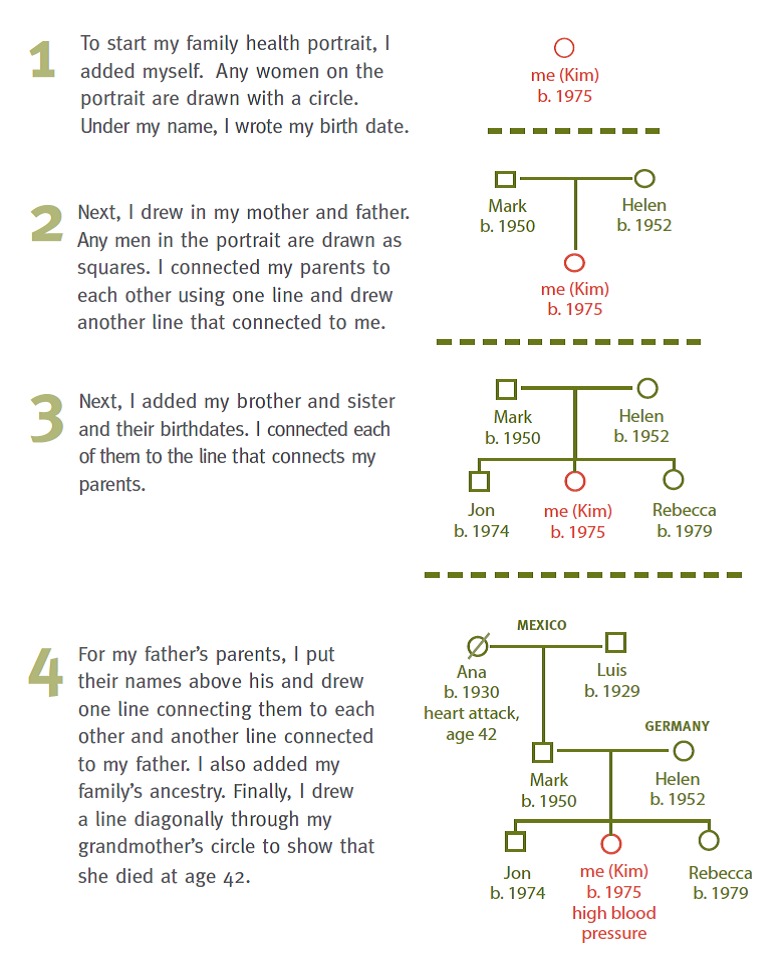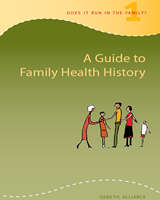All Genetic Alliance content, except where otherwise noted, is licensed under a Creative Commons Attribution License, which permits unrestricted use, distribution, and reproduction in any medium, provided the original work is properly cited.
NCBI Bookshelf. A service of the National Library of Medicine, National Institutes of Health.
Genetic Alliance. A Guide to Family Health History. Washington (DC): Genetic Alliance; 2006.
How to organize
The family health history information you collect can be written down or typed into the computer. It is important to write down all of the information so it makes sense to you, your family, and your healthcare provider. We have included some ideas below to help you organize your information.
Family health portrait
A family health portrait is like a family tree showing family members and their health. Because it is a simple picture of your family health history, it can be easily shared with your healthcare provider. Turn to page 18 for more information.
Isabel’s story

My grandmother died of a massive heart attack when she was 39 years old. Even though my mother was so careful about healthcare for our family, she did not know that she had a very serious heart condition. She felt just fine, but during a routine checkup two years ago, a doctor discovered my mother’s uncontrollable heart arrhythmia. Mom was taken to the hospital immediately, and a cardiac pacemaker was implanted the following day. Since the doctors knew my grandmother had died of a heart attack at a young age, they took my mother’s symptoms very seriously.
This knowledge about my mother’s and grandmother’s health scares me, but I feel it is good to know. I know you can feel healthy but have a serious health condition. Whenever I go for my checkups, I always talk to my doctor about my grandmother’s and mother’s heart conditions. She checks my heart thoroughly and always runs a special test on it because of my family health history.
Though I can’t change what happened to my mom and grandmother, I can use the information to manage my health better and lower my risk of heart disease.
Healthcare Provider Card
Online (www.geneticalliance.org/ccfhh), you will find a card to fill out and bring to your provider. The card focuses on concerns you have about your family health history. It also gives your provider more information on how to best use your family health history to figure out your risk for getting a disease.
Family health portrait
If you have access to the Internet, you can use the U.S. Surgeon General’s My Family Health Portrait to create a family health history tree on your computer.
Visit www.familyhistory.hhs.gov.
You can also draw your own family health portrait. Use the example on the next page to help guide you.
Instructions for drawing a family health portrait
• Write your name and the date at the top of a large piece of paper.
• Draw yourself at the center using a square if you are a man or a circle if you are a woman.
• Draw your parents above you and label each symbol with his or her name and birth date (or approximate age).
• Draw a line between them and then draw a line down to you.
• When possible, draw your brothers and sisters and your parents’ brothers and sisters from oldest to youngest, going from left to right across the paper.
• Add the health information you collected for each individual.
• Add the ancestry and any other information you have collected.

Kim’s story


- Organize - A Guide to Family Health HistoryOrganize - A Guide to Family Health History
Your browsing activity is empty.
Activity recording is turned off.
See more...
